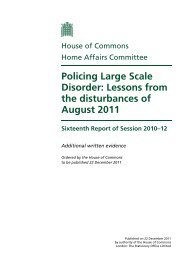Murder and Serious Sexual Assault - Lancaster EPrints - Lancaster ...
Murder and Serious Sexual Assault - Lancaster EPrints - Lancaster ...
Murder and Serious Sexual Assault - Lancaster EPrints - Lancaster ...
Create successful ePaper yourself
Turn your PDF publications into a flip-book with our unique Google optimized e-Paper software.
UNUSUAL PREVIOUS OFFENCES<br />
The relationship between child cruelty or neglect <strong>and</strong> subsequent SSA was not<br />
expected. Five SSA offenders <strong>and</strong> just two controls had child cruelty or neglect of<br />
children in their criminal history. If there had been no differences between the<br />
groups, it would be expected that 20 controls would have child cruelty or neglect in<br />
their criminal record. It is estimated that offenders with this conviction in their<br />
criminal history are nearly ten times as likely to be convicted of a SSA.<br />
Here too, knowledge of the relationship between the offender <strong>and</strong> the victim of the<br />
SSA would have been helpful, in order to establish whether these persons were<br />
more likely to commit a particular kind of SSA (e.g. stranger offences). If this were<br />
the case, then the relative risk score for a particular kind of SSA would probably be<br />
even higher. However, an enhanced dataset would be necessary to confirm this.<br />
In general, those who are convicted of child cruelty also have a first conviction of<br />
some kind occurring at a young age. Only one of the cases had convictions for an<br />
offence other than child cruelty at the same sentencing occasion, while this was the<br />
situation for both controls, <strong>and</strong> for all three, the offence in question was ‘other<br />
wounding etc.’. The most noteworthy feature is the short time between the<br />
conviction for child cruelty or neglect <strong>and</strong> the subsequent conviction for SSA (see<br />
Table 13). One difference between cases <strong>and</strong> controls would appear to be the use of<br />
custody for the cruelty offence among the cases. Three of the five cases, but neither<br />
of the controls, received custodial sentences for the child cruelty offence. This<br />
finding suggests that some of the cases (who were eventually convicted of SSA) had<br />
committed a particularly serious child cruelty offence (although persistent criminal<br />
behaviour may also have been a factor in being awarded a prison sentence).<br />
Whatever the reason, those imprisoned for child cruelty or neglect were at greater<br />
risk of subsequently committing a SSA.<br />
Table 13: Relationship between age <strong>and</strong> sentence for child cruelty or neglect <strong>and</strong><br />
subsequent SSA conviction<br />
Child cruelty or neglect of Sentence awarded SSA conviction<br />
children conviction at age: for Child cruelty etc. at age:<br />
Case A 29 6 years’ imprisonment 30<br />
Case B 23 5 months’ imprisonment 25<br />
Case C 27 2 years’ conditional discharge 31<br />
Case D 35 3 1/2 years’ imprisonment 41<br />
Case E 18 £150 fine 23<br />
37
















